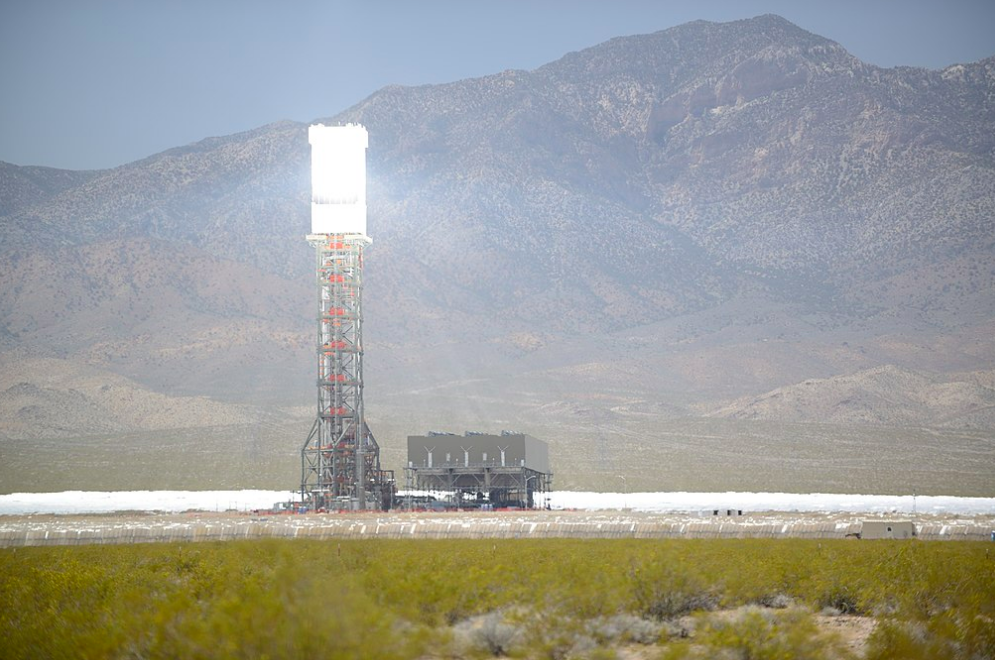The Desert’s No Fly Zone
The Mojave Desert is a 48,000 square mile (124,000 km^2) desert in primarily in southeastern California and southern Nevada. As deserts go, it’s one of the smaller ones, but make no mistake about it — it’s a huge, barren space larger than the whole state of Pennsylvania (but, outside of Las Vegas, with very few human residents). For most of the year, it’s a hot, dry, and sunny — which makes it a great place for a solar power plant.
Unless you can fly.
In October of 2010, construction began on a $2.2 billion solar thermal power plant called the Ivanpah Solar Power Facility. Nestled next to the Clark Mountain Range on the California side of the Nevada border (here’s a map, with satellite view), Ivanpah — like the rest of the Mojave — gets a ton of sunlight year round. The power plant doesn’t use photovoltaics (i.e. “solar panels”) to capture solar energy, though. It, instead, uses steam turbines. A field of mirrors about five square miles bounce refocused sunlight onto one of three 400’ towers, as seen below. Inside those towers are steam-powered turbines and a bunch of water — the sunlight from the mirrors heats the water to temperatures above 500 degrees Celsius (over 900 degrees Fahrenheit), which in turn becomes steam really, really quickly. As a result, Ivanpah is able to generate a good deal of energy — it’s the world’s largest solar thermal power plant — and it’s doing so without creating a similar output in carbon to those which burn coal or the like.

But Ivanpah isn’t a darling of environmental groups. In fact, the opposite may be true. Part of the objection is a generalized objection to man’s intrusion on nature — Ivanpah was built in an otherwise pristine area, creating a jarring field of technology in an area otherwise undeveloped area. The bigger, tangible objection, though, was the impact on the bird populations whose migratory paths cross the area.
Insects, as you have likely experienced, tend to be attracted to bright lights. For humans, that’s a good thing to know as we fight off pests — bug zappers, for example, take advantage of this key piece of information. Many birds, as it turns out, also leverage this knowledge. If you’re a bird who eats flying bugs, you may keep a lookout for bright lights, because chances are, you’ll be able to find a meal near there. So, imagine you’re a bird, migrating across the Mojave Desert, and all of a sudden, there’s this 400’ high glowing thing a bit over that way. That’s your next stop.
It’s also, very possibly, your last. The focused sunlight aimed at those towers brings with it a lot of heat — that’s the whole point! — but the birds don’t know that. And they don’t even have to get to the tower before it is too late. The entire region above those mirrors can get very hot, very fast, and as Gizmodo notes, “the birds, in search of a tasty meal, are instantly set ablaze, and then spiral to the ground like a World War II-era Messerschmitt downed by anti-aircraft fire.”
That’s bad. And to make matters worse, it’s also not easily solved. According to the Los Angeles Times, officials have “replaced floodlights with LED bulbs” (which don’t attract as many insects), “fitted each tower with machines that emit a nonlethal avian respiratory irritant derived from grape juice concentrate,” and have attached “devices that broadcast digital recordings of loud, high-pitched shrieking noises” to the towers. So far, results have been less than promising — birds are still flying toward the light, and ultimately, to their death.
According to the most reliable estimates, approximately 6,000 birds fall to the towers each year. That may be a lot, but as of now, those in charge think that it’s an acceptable price to pay for Ivanpah’s power output. And maybe they’re right. According to the Weather Channel, “the facility at Ivanpah generates enough electricity to power 140,000 homes and eliminates carbon dioxide emissions equivalent to 72,000 vehicles a year.”
Bonus fact: The first ever Indianapolis 500 (the automobile race) took place in 1911. The winning driver, Ray Harroun, finished the 200-lap, 500-mile race in 6:42:08, beating the second place finisher by one minute and 43 seconds. Harroun’s secret, though, wasn’t just better driving — it was better aerodynamics. All the other racers had a passenger in their car called a “riding mechanic,” who, among other things, “was to look backward and alert the driver to what was going on behind him,” per the New York Times. Harroun, though, drove solo, and as a result, was pulling less weight than the other 39 drivers. How’d he manage to do so safely? He was the only one to replace his mechanic with a piece of cutting edge technology at the time: a rear-view mirror.
From the Archives: Let There Be Light: The town which mirrored itself into a few hours of daylight.
